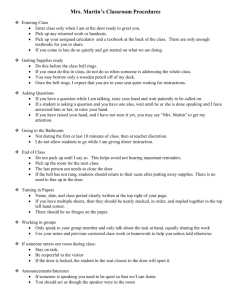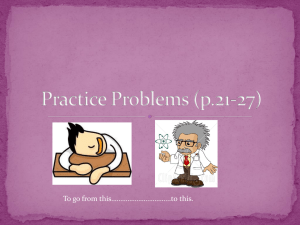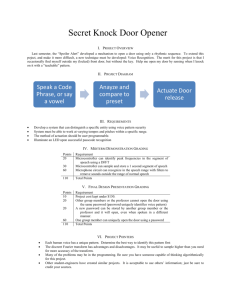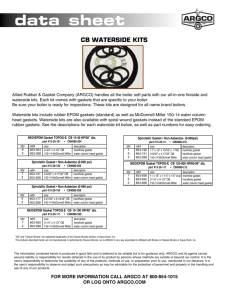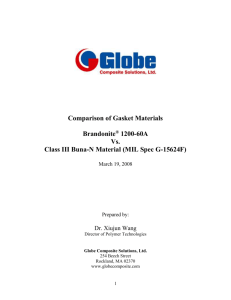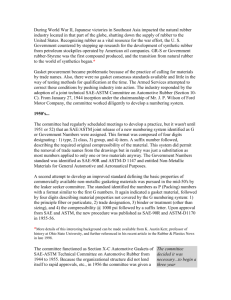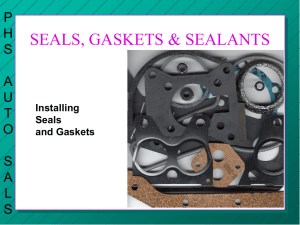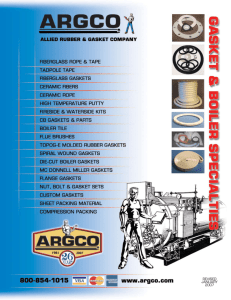The status of this measure should be changed to Out-of
advertisement
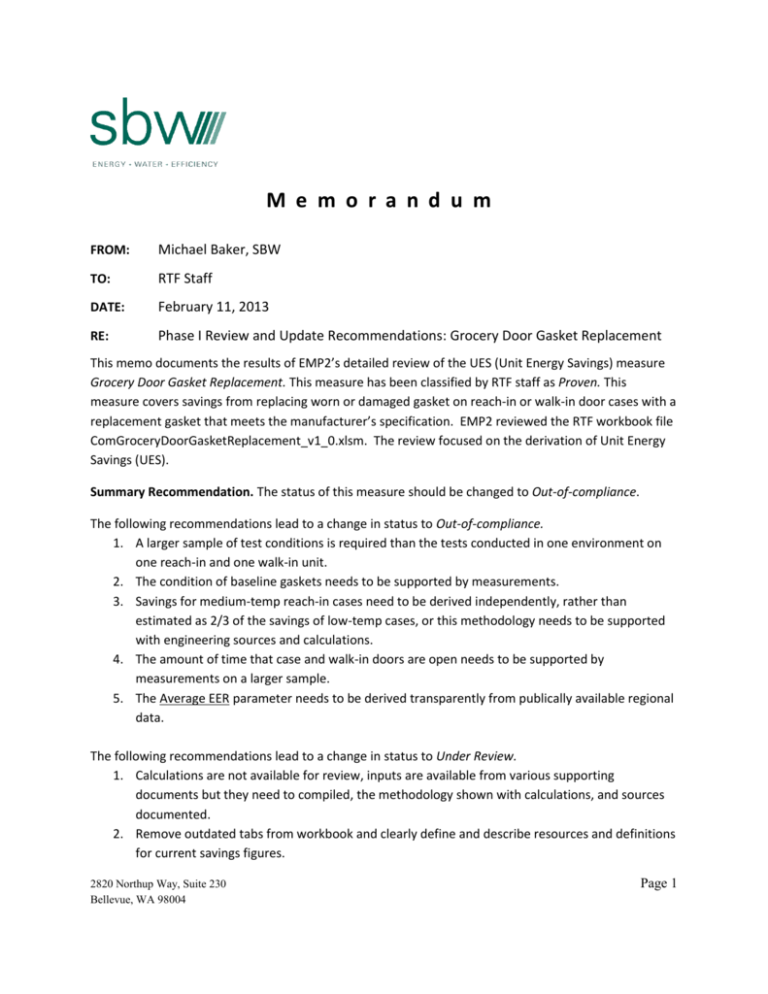
M e m o r a n d u m FROM: Michael Baker, SBW TO: RTF Staff DATE: February 11, 2013 RE: Phase I Review and Update Recommendations: Grocery Door Gasket Replacement This memo documents the results of EMP2’s detailed review of the UES (Unit Energy Savings) measure Grocery Door Gasket Replacement. This measure has been classified by RTF staff as Proven. This measure covers savings from replacing worn or damaged gasket on reach-in or walk-in door cases with a replacement gasket that meets the manufacturer’s specification. EMP2 reviewed the RTF workbook file ComGroceryDoorGasketReplacement_v1_0.xlsm. The review focused on the derivation of Unit Energy Savings (UES). Summary Recommendation. The status of this measure should be changed to Out-of-compliance. The following recommendations lead to a change in status to Out-of-compliance. 1. A larger sample of test conditions is required than the tests conducted in one environment on one reach-in and one walk-in unit. 2. The condition of baseline gaskets needs to be supported by measurements. 3. Savings for medium-temp reach-in cases need to be derived independently, rather than estimated as 2/3 of the savings of low-temp cases, or this methodology needs to be supported with engineering sources and calculations. 4. The amount of time that case and walk-in doors are open needs to be supported by measurements on a larger sample. 5. The Average EER parameter needs to be derived transparently from publically available regional data. The following recommendations lead to a change in status to Under Review. 1. Calculations are not available for review, inputs are available from various supporting documents but they need to compiled, the methodology shown with calculations, and sources documented. 2. Remove outdated tabs from workbook and clearly define and describe resources and definitions for current savings figures. 2820 Northup Way, Suite 230 Bellevue, WA 98004 Page 1 3. Measure definition needs to clarify that the measures are per door rather than per foot. 4. Measure definition needs to be clarified as to how damaged a length of gasket needs to be to qualify for a rebate. 5. HVAC interaction should be considered in the estimation of measure savings. 6. Test results need to be normalized from lab conditions to regional average EER values. 7. The methodology used to calculate the Anomaly Impact Factor, which normalizes test results to account for differences in environmental conditions between the baseline and efficient cases, needs to be more fully documented. Limitation of Review. PECI’s Engineering Specification for GrocerSmart™ 3.0 was not available or included as part of this review. HVAC interactive factors used in the 6th Plan were not reviewed. Alterations to Workbook and Documentation. Since a standardized RTF measure workbook was not available, the standardized workbook ComGroceryDoorGasketReplacement_v1_0.xlsm was developed using supporting information from the RTF workbook DeemedMeasuresV26.xls and EnergySmartGrocer-March 2009V2_15.xls. A sheet called “Summary” has been added to the workbook. This sheet describes how measures are identified, lists important constants and their sources, describes the savings estimation algorithm and the associated baseline and efficient case parameters and their sources for each measure and UES component. Supporting workbook and formulas were not available for review. In an attempt to recreate the approved savings methodologies, EMP2, Inc included four additional tabs “gaskets 2012 worksheet”, “Normalized EER”, “gasket 2012 summary”, and “Door Open Times”. These worksheets attempt to identify the methodologies that support the RTF approved figures. o A sheet called “gaskets 2012 worksheet” has been added to the workbook. This worksheet source is from PECI and shows how the Emerson Laboratory Test Results were modified to determine RTF approved savings figures (savings do not all match). o A sheet called “normalized EER” has been added to the workbook. This worksheet source is from PECI and shows how the savings for the reach-in low temperature case savings was normalized to account for discrepancies between the damaged and full gaskets test provided by Emerson Test Laboratory Results. This also shows how the 1.7 kWh per day discrepancy was calculated. o A sheet called “gaskets 2012 summary” has been added to the workbook. This worksheet attempts to verify how the RTF approved savings were derived using various figures from the November 2008 presentation and Emerson Test Laboratory Page 2 Results. This worksheet also includes supporting material from the Nov, 2008 RTF meeting – a statement from PECI describing typical gasket damage, and the table summarizing door open times. o A sheet called “Door Open Times” has been added to the workbook. This sheet shows results from metering of cooler and freezer door open times (presumably by BPA). In addition, some summary statistics have been added. Recommendations for Updates. The RTF should implement the following recommendations: 1) Workbook Structure and Formulas a) The worksheets “gaskets 2012 worksheet”, “Normalized EER”, “gasket 2012 summary”, and “Door Open Times” need to be updated and fully documented, with formulas clearly shown. This deficiency causes a change of status to Under Review. b) Most of the supporting documentation in ComGroceryDoorGasketReplacement_v1_0 support figures from an outdated calculation methodology or support measures outside of the door gasket replacement measure. The original savings methodology was based on an ASHRAE infiltration calculation. Now that the savings are based on actual infiltration lab testing results these outdated tabs should be removed (gaskets, gaskets 2009, RI Gaskets, and WI Gaskets). Other tabs that do not support this measure also need to be removed (general, RF Background). The gasket background tab needs to be updated to support current savings methodology and savings figure. This deficiency causes a change of status to Under Review. 2) Documentation a) No recommendation. 3) Measure Definition a) The measure definition was initially based on a per foot of gasket. Measures approved at the November 2008 meeting were on a per door basis. The current documentation doesn’t clearly specify the measure definition as based on a per door basis. EnergySmartGrocer- March 2009V2_15.xls still includes per linear foot measures in addition to per door measures. The per foot savings values appear to be derived from the per door savings combined with linear feet per door from the presentation at the meeting. However, the basis is not clear for the linear feet per door values for walk-in spaces in that presentation (in the cost section). The values are too low for a complete gasket replacement on a walk-in door. The definition of both per door (complete replacement or partial?) and per linear foot measures needs to be clarified. This causes a status change to Under Review. b) The measure definition states that the new gasket “must replace a worn or damaged gasket.” This statement is too vague since it could apply to gaskets which are effective infiltration barriers as well as those which are not. This specification should be updated as a result of Page 3 investigations into the condition of baseline gaskets. This causes a status change to Under Review. 4) UES Savings Estimation Method a) At the core of the savings estimates are laboratory tests on one reach-in freezer and one walk-in environmental unit configured to simulate conditions of a walk-in freezer and a walk-in cooler with simulated damaged and undamaged gaskets. These limited test conditions do not meet the standards for statistical, meta-statistical, or calibrated engineering methods of estimating savings. A larger sample of test conditions is required to validate the conclusions. This causes a status change to Out-of-compliance. b) Savings estimates are based on laboratory testing of freezers and coolers with simulated damaged gaskets. The damaged gasket condition was achieved by creating spaces in the gaskets in an attempt to simulate gasket conditions that are stated in the RTF Status Report Power Point Presentation given in November of 2008 as follows. These observations do not constitute a sufficiently quantitative basis to establish the condition of the baseline gaskets. ADM (2008) found a significantly lower rate of gasket damage than that described above. ADM found that gaskets were often replaced for aesthetic reasons while they were still effective at preventing infiltration. The ADM study, which applied only to reach-ins, was not able to estimate the condition of replaced gaskets with high confidence. The infiltration allowed in the field by baseline gaskets needs to be determined by measurement. This causes a status change to Out-of-compliance. Page 4 c) Three of the four measures are directly supported by individual laboratory test procedures as performed by Emerson Technologies (Reference 1,2,3). However, the savings figure for the reach-in glass doors medium temperature measure is simply estimated assuming a 67% factor of the reach-in glass door low temperature measure figures. This estimation method must be documented with supporting data or revised based on similar test procedures for reach-in glass door medium temperature studies. This causes a status change to Out-of-compliance. d) HVAC interaction should be considered in the estimation of measure savings. The net electric HVAC interaction factor assumed in the 6th Plan for lighting measures in groceries was 1%. The gas impact was negative .01 therms per kWh saved. The electric impact is small, but should be noted. Impacts will need to be re-estimated for this measure based on the reduction in heating load in the environment that corresponds to the reduction in cooling load inside the refrigerated space (rather than based on kWh saved). This problem causes a change of status to Under Review. e) Test results need to be normalized from lab conditions to regional average EER values, which PECI is currently under contract to the RTF to update. This deficiency causes the measure to change the status to Under Review. 5) Input Parameters a) The Emerson Laboratory Test Results savings were modified by estimates of the percent door open time as shown in the November 2008 Power Point Presentation. These door open times are based on actual field measurements but the % open times have a large variance and the mean has low confidence. The median door open time was used for three of the four cases, apparently to compensate for the impact of significant outliers in the data; the mean was used for the fourth. A large enough sample size such that the mean can be used with confidence is required for this parameter. The ADM study estimated this parameter for reach-ins with a high level of confidence. However, it is not possible to completely evaluate this study as a source for this parameter without a more detailed look at the data than is provided by the report. This deficiency causes a status change to Out-of-compliance. b) The Average EER parameter is based on proprietary DOE 2.2-R simulations of Northwest grocery environments. This parameter needs to be derived transparently from publically available data. This deficiency causes a change of status to Out-of-Compliance. c) Based on the November 2008 Grocery Store Measures – RTF Status Report III-4 Power Point Presentation it appears that an anomaly impact factor of 1.7 kWh per day was applied to the savings based on page 16 of 24 of the presentation. This increases the laboratory testing result savings by roughly 100%. This has a large impact on savings with little supporting documentation. EMP2, Inc. included an additional worksheet titled “Normalized EER” that describes how this anomaly was derived. This worksheet was provided by PECI. The PowerPoint states that the normalization is due to differences in the test conditions between Page 5 the baseline and measure test. The methodology used to calculate this anomaly needs to be fully documented. This causes a status change to Under Review. Additional Considerations. 1) Sunset criteria – Five years from date of approval. 2) The ADM study offers an alternative savings estimation methodology, based on field measurements of infiltration, combined with engineering calculations of the energy impacts of the infiltration. However, the engineering calculations were not calibrated to actual energy consumption data. Sources Energy Usage of a Reach-In Freezer With Various Gasket Conditions, Design Services Network, Test Performed by Max Gingrich, Report Prepared by Steve Pfister & Georgi Kazachki, Design Services Network, August 21, 2008. 2 Energy Usage of a Walk-In Freezer With Various Gasket Conditions, Design Services Network, Test Performed by Max Gingrich, Report Prepared by Steve Pfister & Georgi Kazachki, Design Services Network, September 20, 2008. 3 Energy Usage of a Walk-In Cooler With Various Gasket Conditions, Design Services Network, Test Performed by Max Gingrich, Report Prepared by Steve Pfister & Georgi Kazachki, Design Services Network, October 21, 2008. 4 Commercial Facilities Contract Group Direct Impact Evaluation Final Report, ADM Associates, Inc. for California Public Utilities Commission Energy Division, February 18, 2010 Page 6




